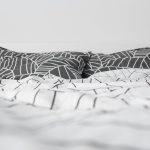You can make plenty of easy, durable projects with polycotton, like custom pillow covers that fit perfectly and pop with color, lightweight curtains that brighten rooms, and sturdy tote bags ideal for everyday use. Aprons, tablecloths, and placemats also come together quickly and hold up well. Polycotton’s wrinkle resistance and softness make it great for pajamas and laptop sleeves too. Keep exploring, and you’ll find even more creative ideas to try for your home and wardrobe.
Table of Contents
Key Takeaways
- Polycotton is ideal for easy home decor projects like custom pillow covers, lightweight curtains, and durable tablecloths.
- Create versatile fashion accessories such as tote bags, aprons, and cozy pajama pants with polycotton fabric.
- Make soft and durable baby items like adjustable bibs, incorporating waterproof layers for practicality.
- Sew protective laptop sleeves using polycotton combined with padding and closures like zippers or Velcro for function and style.
- Choose beginner-friendly patterns and simple closures to ensure successful and enjoyable polycotton sewing projects.
Custom Pillow Covers
Creating custom pillow covers with polycotton is a simple way to refresh your home decor. You’ll appreciate how this fabric blends durability with softness, making your pillows both comfortable and long-lasting.
Start by measuring your pillow insert to cut the fabric precisely, ensuring a snug fit. Polycotton’s easy-to-sew nature means you can finish your project quickly, even if you’re a beginner.
Measure your pillow insert carefully for a perfect fit; polycotton makes sewing easy and quick for all skill levels.
Choose vibrant prints or subtle patterns to match your room’s style effortlessly. Use a zipper or envelope closure so you can remove covers for washing without hassle.
Once sewn, your new pillow covers will add a personalized touch and instantly brighten your living space. You’ll find this project rewarding and a great introduction to working with polycotton fabric.
Lightweight Curtains
You’ll love how polycotton curtains bring a perfect balance of durability and softness to your windows.
They’re lightweight, easy to sew, and let just the right amount of light filter through.
Let’s explore how to style these curtains to enhance any room effortlessly.
Benefits of Polycotton Curtains
Although curtains come in many fabrics, polycotton stands out for its lightweight feel and practical benefits.
When you choose polycotton curtains, you get a fabric that’s breathable yet durable, making it perfect for regulating light without weighing down your windows. You’ll appreciate how easy they’re to sew, thanks to their smooth texture and stable weave.
Plus, polycotton resists wrinkles and shrinks less than pure cotton, so your curtains maintain a crisp, fresh look with minimal effort. They’re also easy to clean and quick-drying, which suits busy households.
If you want curtains that balance style, function, and maintenance, polycotton is a smart choice. Its blend of natural and synthetic fibers gives you versatility and long-lasting use without sacrificing comfort.
Styling Lightweight Window Treatments
When you choose lightweight curtains made from polycotton, you open up a world of styling possibilities that enhance both natural light and room ambiance.
You can easily sew simple panels that gently diffuse sunlight, creating a soft, inviting glow. Consider adding subtle patterns or colors to complement your décor without overpowering the space.
Because polycotton is durable yet breathable, your curtains will hang beautifully and resist wrinkles. You might also try layering these lightweight curtains with heavier drapes for versatility—letting in light during the day and adding privacy at night.
With just basic sewing skills, you can customize hems, add tabs, or insert grommets, tailoring your window treatments to fit your style perfectly.
This fabric’s ease of care means your curtains will stay fresh and vibrant with minimal effort.
Tote Bags
Since polycotton combines durability with ease of care, it makes an excellent choice for tote bags that can handle daily use. You’ll appreciate how this fabric resists wrinkles and holds up to frequent washing, keeping your tote looking fresh.
Plus, polycotton’s blend offers a nice balance of strength and softness, so your bag feels comfortable to carry. When sewing, you can create simple, sturdy designs with reinforced handles and spacious interiors. Don’t hesitate to add pockets or compartments for organization.
Whether you’re making a grocery tote or a casual everyday bag, polycotton is versatile enough to suit your style. With minimal effort, you’ll have a practical, attractive tote that’s ready to go anywhere with you.
Tablecloths and Placemats
Tablecloths and placemats crafted from polycotton bring both style and practicality to your dining space. You’ll appreciate polycotton’s durability and easy-care qualities, making these items perfect for everyday use or special occasions. Plus, patterns and colors stay vibrant wash after wash. Whether you’re sewing a full tablecloth or simple placemats, polycotton handles spills and frequent laundering with ease.
Here’s a quick comparison to help you decide what to make:
| Feature | Tablecloths |
|---|---|
| Coverage | Full table coverage |
| Visual Impact | Bold centerpiece |
| Ease of Sewing | Larger project |
| Maintenance | Machine washable |
| Use Cases | Formal & casual |
Choose polycotton for a blend of beauty and function at your next meal.
Aprons
Polycotton’s durability and easy-care nature make it a great choice beyond table linens—aprons are another practical project to tackle.
When you sew an apron with polycotton, you get a sturdy, washable garment that stands up to kitchen messes and frequent laundering.
You can customize your apron with:
- Adjustable neck straps for a perfect fit
- Deep pockets to hold utensils or recipe cards
- Contrasting trims for a pop of color
- Reversible designs for two looks in one
- Fun prints or patterns that brighten your cooking space
With polycotton, your apron won’t wrinkle easily, making it ideal for everyday use.
Plus, it’s simple to sew, so even beginners can whip up a stylish, functional apron in no time.
Simple Skirts
Creating simple skirts with polycotton lets you craft comfortable, durable garments perfect for everyday wear.
This fabric’s blend offers just the right amount of structure and softness, making it ideal for skirts that hold their shape without feeling stiff. You can easily sew A-line or gathered skirts, both beginner-friendly styles that require minimal pattern pieces.
Polycotton’s easy-care properties mean your skirt will resist wrinkles and wash well, keeping it looking fresh longer. Choose prints or solid colors to match your wardrobe, and add practical features like elastic waistbands or pockets.
With straightforward sewing techniques, you’ll finish a skirt quickly and enjoy wearing a handmade piece tailored to your style and comfort needs.
Reusable Face Masks
Although face masks have become a daily essential, you can make reusable ones at home using polycotton fabric that balances breathability with durability.
Polycotton’s blend makes it ideal for masks that are comfortable yet sturdy enough to withstand frequent washing.
When sewing your own, keep these tips in mind:
- Use multiple layers for better filtration.
- Choose tightly woven polycotton for effective protection.
- Add adjustable ear loops or ties for a custom fit.
- Include a pocket to insert a filter if desired.
- Verify the mask covers both nose and mouth snugly without gaps.
Baby Bibs
When making baby bibs, you’ll want to pick soft polycotton to keep your little one comfortable.
Choose easy patterns that save time but still look great.
Don’t forget to add a waterproof layer to protect clothes from spills and messes.
Choosing Soft Polycotton
Since baby bibs need to be gentle on sensitive skin, you’ll want to choose soft polycotton fabrics that combine comfort with durability.
Look for blends that feel smooth and won’t irritate your little one. When picking your fabric, consider these key features:
- High thread count for softness and strength
- Breathable weave to prevent overheating
- Easy-to-wash materials that withstand frequent laundering
- Hypoallergenic properties to reduce skin reactions
- Colorfastness to keep patterns vibrant after multiple washes
Selecting the right polycotton guarantees your bibs stay cozy and functional.
Easy Bib Patterns
You’ll find several easy bib patterns that suit different skill levels and styles, making them perfect for quick sewing projects. Polycotton’s durability and softness make it ideal for baby bibs. Whether you prefer classic rounded shapes or trendy bandana styles, these patterns are beginner-friendly and fast to complete. Using simple stitching and minimal pieces, you can customize bibs with fun prints or color blocks.
Here’s a quick comparison of popular easy bib patterns:
| Pattern Type | Skill Level | Features |
|---|---|---|
| Classic Rounded | Beginner | Simple shape, snap closure |
| Bandana Style | Easy | Trendy, triangular cut |
| Adjustable Bib | Intermediate | Velcro straps, size options |
Try one to create a useful, cute accessory for your little one in no time!
Waterproof Layer Options
Adding a waterproof layer to your polycotton baby bibs can keep them cleaner and more practical for everyday use.
You’ll want materials that block moisture but still feel comfortable against your baby’s skin. Here are some great waterproof options to evaluate:
- PUL (Polyurethane Laminate): Lightweight and flexible, perfect for bibs.
- Thermoplastic vinyl: Easy to wipe clean but less breathable.
- Fleece: Naturally water-resistant and soft.
- Laminated cotton: Combines cotton’s look with waterproof functionality.
- Silicone-coated fabrics: Durable and resistant to stains and liquids.
Fabric Banners and Bunting
When you choose polycotton for fabric banners and bunting, you get a durable yet lightweight material that holds colors brilliantly. It’s easy to cut and sew, making your project quick and enjoyable. Polycotton resists wrinkles and fading, so your decorations stay vibrant for parties or everyday charm. Plus, it’s strong enough to handle outdoor use without tearing.
Here’s a quick look at why polycotton works well:
| Feature | Benefit | Result |
|---|---|---|
| Durability | Resists wear | Long-lasting banners |
| Lightweight | Easy to hang | No sagging or drooping |
| Colorfastness | Holds dyes well | Bright, eye-catching |
Use polycotton to create festive, reusable banners that brighten any space!
Quilted Coasters
Creating quilted coasters with polycotton combines practicality and style in just a few simple steps. You’ll love how this fabric’s durability and easy-care nature make it perfect for everyday use.
Start by cutting your polycotton into small squares, then layer them with batting for that cozy quilted feel. Sew around the edges, add a simple pattern or stitch design, and you’ve got charming coasters ready to protect your surfaces.
Here’s what you’ll need:
- Polycotton fabric scraps
- Cotton batting
- Rotary cutter or fabric scissors
- Sewing machine or needle and thread
- Iron for pressing seams
These coasters are a quick project that adds a handmade touch to any room while being super functional.
Pajama Pants
Although sewing pajama pants might seem challenging at first, polycotton’s softness and breathability make it an ideal choice for comfortable sleepwear.
You’ll appreciate how easy it’s to work with this fabric—it’s less slippery than pure cotton and holds its shape well. Start by selecting a simple pattern with an elastic waistband for a relaxed fit. Cut your fabric carefully, ensuring the print or pattern aligns if you’re using a design.
When sewing, use a stretch stitch or a narrow zigzag to allow for movement without breaking seams. Finish the edges with a serger or a zigzag stitch to prevent fraying.
In no time, you’ll have cozy, durable pajama pants perfect for lounging or sleeping.
Cloth Napkins
If you want to add a touch of elegance and sustainability to your dining table, sewing cloth napkins with polycotton is a perfect project.
Polycotton’s durability and easy-care qualities make it ideal for everyday use. You can customize napkins with different colors, patterns, and finishes to match your style.
Durable and easy-care polycotton lets you personalize napkins with colors, patterns, and finishes to suit your style.
Here’s why you’ll love making cloth napkins from polycotton:
- They’re machine washable and wrinkle-resistant
- You can create matching sets for special occasions
- Polycotton resists stains better than pure cotton
- They reduce waste compared to disposable napkins
- Simple straight seams make sewing quick and beginner-friendly
Start with a basic square shape, add a hem, and you’ll have elegant, reusable napkins ready to impress your guests!
Zipper Pouches
One versatile sewing project you’ll enjoy is making zipper pouches from polycotton. This fabric’s durability and easy-care qualities make it perfect for crafting pouches that hold up well to daily use.
You can create small pouches for coins or makeup, or larger ones for organizing craft supplies or travel essentials. Polycotton’s smooth texture allows the zipper to glide effortlessly, ensuring a neat finish.
Plus, its wide range of prints lets you personalize each pouch to suit your style. Sewing zipper pouches also helps you practice precise stitching and inserting zippers, boosting your sewing skills.
Whether for yourself or as thoughtful handmade gifts, polycotton zipper pouches combine function and fashion with minimal effort. Give this project a try—you’ll love the results!
Summer Dresses
Creating summer dresses from polycotton offers you a perfect blend of comfort and style. This fabric’s breathability and durability make it ideal for warm weather, while its easy-care nature guarantees your dress stays fresh.
You can whip up dresses that are both cute and practical without fuss.
Here’s why polycotton is great for your summer dress projects:
- Lightweight and breathable, keeping you cool
- Holds vibrant prints and patterns beautifully
- Easy to sew, perfect for beginners
- Resistant to wrinkles, so your dress looks neat all day
- Durable enough for everyday wear and washing
With these benefits, your polycotton summer dress will be a go-to favorite for casual outings or beach days, combining ease and fashion effortlessly.
Laptop Sleeves
When making laptop sleeves with polycotton, you’ll want to choose protective padding that keeps your device safe without adding bulk.
You can also get creative with stylish closures like zippers, buttons, or Velcro to match your look.
Let’s explore how to combine function and fashion in your next sewing project.
Protective Padding Options
Although polycotton isn’t inherently padded, you can easily add protective layers to craft durable laptop sleeves that guard your device against bumps and scratches.
Choosing the right padding enhances both protection and comfort, making your sleeve more functional and stylish.
Consider these protective padding options:
- Foam batting: Lightweight and cushy, great for shock absorption.
- Quilted cotton: Adds texture and moderate padding.
- Felt: Dense and firm, excellent for scratch resistance.
- Neoprene: Water-resistant with excellent cushioning.
- Fusible fleece: Easy to apply, adds thickness without bulk.
Mix and match these layers to balance protection and weight, ensuring your polycotton laptop sleeve stays sleek yet secure.
Stylish Closure Designs
Adding protective padding gives your polycotton laptop sleeve durability, but choosing the right closure keeps your device secure and complements your style.
You can opt for a simple zipper closure, which offers reliable security and a clean finish. If you want something quicker to open, consider magnetic snaps—they’re discreet and easy to use.
Velcro strips provide a budget-friendly option and add a casual touch, perfect for everyday use. For a more sophisticated look, try a button and loop closure or a leather strap with a buckle; these add unique charm while keeping your laptop safe.
Whatever you choose, make sure the closure aligns with your sewing skills and the sleeve’s overall design, ensuring both functionality and style.
Frequently Asked Questions
How Do I Care for Polycotton Fabric After Washing?
Think of polycotton as a sturdy friend who loves gentle care. You’ll want to wash it in cold water, avoid bleach, and tumble dry low. Iron on medium heat to keep it looking fresh and lasting longer.
Can Polycotton Fabric Be Used for Upholstery Projects?
You can use polycotton for upholstery, but it’s best for light-use items like cushions or slipcovers. It’s durable and easy to clean, but might not hold up well under heavy wear or constant friction.
What Type of Sewing Machine Needle Works Best With Polycotton?
You don’t need a magic wand—just a universal needle size 80/12 or 90/14 will do. Polycotton is forgiving, so pick one and sew confidently; your machine won’t judge your fabric choices.
Is Polycotton Fabric Suitable for Outdoor Sewing Projects?
You can use polycotton for outdoor sewing projects since it’s durable and resists wrinkles. However, it’s not fully waterproof, so you might want to treat it or use a protective coating for better weather resistance.
How Does Polycotton Compare to 100% Cotton in Breathability?
You’ll find polycotton less breathable than 100% cotton because the polyester blend reduces airflow. However, it’s more wrinkle-resistant and durable, making it a practical choice when you want easier care without sacrificing too much comfort.
- Achieving the Perfect Ombre: A Step-by-Step Dyeing Guide - July 13, 2025
- Step-by-Step Crumple Tie-Dye for a Marbled Effect - July 13, 2025
- A Deep Dive Into Resist Dyeing Techniques - July 13, 2025







